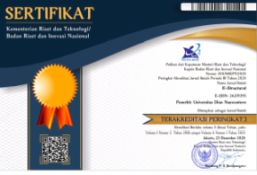Techniques of Translating Interjection in the Novel “Looking For Alaska” in Terms of Functions, Meanings, and Categories
Abstract
The objective of this research is to find out the functions, meanings, and categories of interjections, and the translation technique practiced by the Indonesian translator to translate English interjection found in the novel Looking for Alaska or Mencari Alaska in Indonesian. This research is adopting a descriptive qualitative, with the novel of Looking for Alaska and Mencari Alaska as the primary source of the data. Since the data collection of interjections is found in the book, it can be classified as content analysis. The researchers found out that there are six translation techniques used by the translators to translate interjections, six kinds of interjections in terms of functions and meanings, and three kinds of interjections in terms of categories found in the novel. Those six translation techniques are 164 interjections (41,21%) for literal translation technique, 49 interjections (12,31%) for translation by using an interjection with similar meaning and form technique, 61 interjection (15,33%) for translation by using an interjection with different forms, but the same meaning, 11 interjections (2,76%) for partly deleted omission technique, 9 interjections (2,26%) for total deleted omission technique, 8 interjections (2,01%) for addition technique, 58 interjections (10,80%) for pure borrowing technique, and 53 interjections (13,32%) for naturalized borrowing technique. From the research finding of the interjection regarding functions and meanings, there is a total of 419 types of English interjections where the researchers divided into six classes. Those types of function are: 5 (1,19%) data of interjection are used to greet, 35 (8,35%) data of interjection are used to express joy, 57 (13,37%) data of interjection are used to get attention, 169 (40,33) data of interjection are used to express approval, 120 (28,64%) data of interjection are used to express a surprise, and 34 (8,11) data of interjection used to express sorrow. Then from the research finding of interjection regarding category, there is a total of 419 data of English interjections where the researchers divided into three classes, those classes are 72 (17,18%) data of primary interjection, 336 (80,19%) data of secondary, and 11 (2,63%) data of onomatopoeic interjection. The findings of this study show that the translation techniques mostly used by the translators to translate an English interjection is translation by literal translation and translation by borrowing technique. In contrast, the least used translation technique is the addition technique that the translators rarely used it to translate the interjection.
Keywords: Interjection, Interjection Translation, Looking for Alaska, Mencari Alaska, Translation Technique.Full Text:
PDFDOI: https://doi.org/10.33633/es.v3i01.3854
Article Metrics
Abstract view : 594 timesPDF - 716 times
Refbacks
- There are currently no refbacks.
Accredited by:
Indexed by:
In Collaboration with:

This work is licensed under a Creative Commons Attribution 4.0 International License.

























